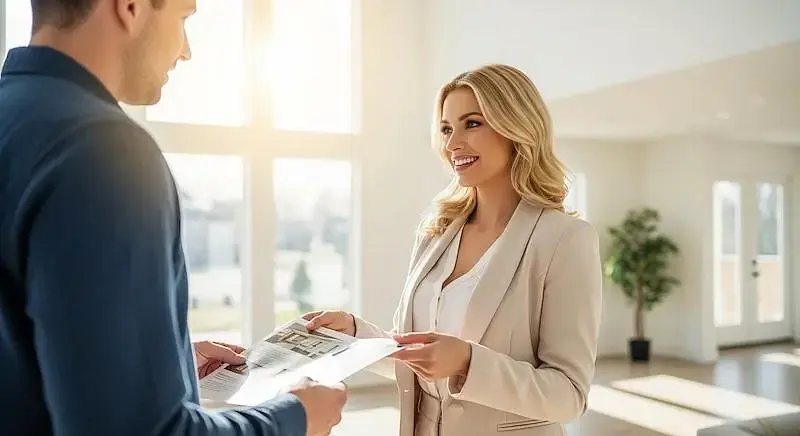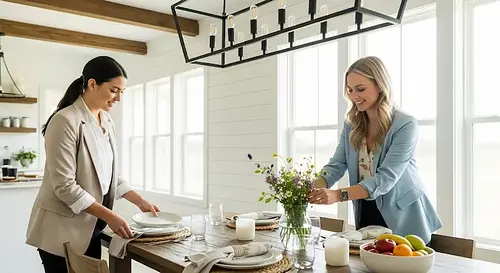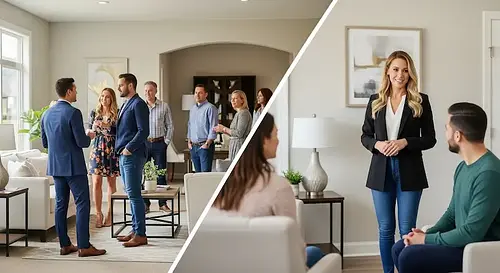Open House Materials Every Realtor Needs On Hand
Want to know exactly which open house materials will help you stand out, capture leads, and convert more visitors into clients? This guide breaks down the essential open house materials every Realtor needs on hand—plus pro tips to help you host high-converting events with confidence.

Written by Seth Cox
Jul 02, 2025 / Open house marketing
In this guide, we’ll walk you through every must-have item for real estate open houses, explain what to bring to an open house as a Realtor, and share expert strategies to make sure your materials work hard for you. If you’ve ever wondered how to host a high-converting open house, this is your blueprint.

Flyers and Brochures
When designing effective flyers and brochures, consider these best practices:
- Property Overview: Clearly present critical details such as square footage, room count, upgrades, and standout features.
- Visual Appeal: Use professional, high-resolution images to capture attention and highlight the property's strengths, like recent remodels, beautiful landscaping, or spacious living areas.
- Clear Contact Information: Make sure your name, phone number, email address, and website are prominently displayed to facilitate follow-ups.
Additionally, it's beneficial to include local market highlights or neighborhood selling points, creating added context and value for potential buyers.

Sign-In Sheets and Digital Sign-In Systems
Here’s how to make the most of your open house sign-in strategy:
- Use a branded digital sign-in app: Tools like Showable make it easy to collect guest information and instantly sync it with your CRM for automated follow-up.
- Ask the right questions: Collect names, emails, phone numbers, and whether the visitor is working with an agent or currently house hunting.
- Make it easy and welcoming: Use a tablet or phone at the front door and encourage sign-in with a smile. You can even offer a giveaway entry as incentive.
- Avoid manual entry errors: Digital sign-ins reduce the risk of unreadable handwriting or forgotten details, ensuring your follow-up is accurate and timely.
By upgrading from paper to a professional digital sign-in experience, you’ll capture more leads, streamline your workflow, and demonstrate that you take your business—and your visitors—seriously.

Local Market Reports
- Include key stats buyers care about: Median home prices, days on market, list-to-sale ratios, and recent sales in the area.
- Use visuals to tell the story: Charts, graphs, and infographics make your data easier to digest and more memorable.
- Personalize the content: Focus on the immediate neighborhood or school district where the home is located—don’t just share generic city-wide stats.

Business Cards
To make your business cards stand out:
- Keep the design clean and professional: Use your brand colors, a readable font, and high-quality materials that reflect your credibility as an agent.
- Include essential contact details: Name, phone number, email address, website, and your social media handles (if you actively post about listings or the market).
- Add a QR code: Link directly to your digital business card, open house landing page, or a property portfolio to make following up even easier.
- Leave them in multiple spots: Place a stack near the sign-in station, next to brochures, and even inside each room of the home.

Directional Signs
- Place signs at high-traffic intersections: Use arrows to guide drivers from major roads to the property. Add your name or logo to reinforce your brand.
- Follow local sign ordinances: Always check city or HOA regulations to avoid fines or removal.
- Use bold colors and large fonts: Make sure your signage is visible from a distance and easily readable while driving.
- Add the date and time: Signs that include real-time info feel more urgent and actionable to potential buyers.
- Double up near turns or confusing routes: Help visitors stay on track by placing a second sign right before the turn.
If you want to attract more traffic to your open house, real estate signs can make or break your success. Invest in durable, branded signs that you can reuse—and map out your placement strategy before event day.

Branded Promotional Items
- Choose items people will actually use: Think water bottles on a hot day, mints by the door, or pens at the sign-in table.
- Keep your branding clean and visible: Include your name, logo, and website, but avoid cluttering the design.
- Use quality over quantity: A sleek notebook or a well-made reusable tote goes further than a pile of cheap plastic trinkets.
- Tie your items to the season or theme: For example, offer hand sanitizer in winter, sunscreen in summer, or a branded cookie with coffee at morning events.

Door Prizes and Giveaways
To make your open house giveaway a success:
- Choose universally appealing prizes: Gift cards, wine bottles, candles, or local restaurant certificates tend to attract the most interest.
- Use the prize to drive sign-ins: Require visitors to sign in (digitally or on paper) to be entered—this helps you build your lead list.
- Display the prize prominently: A visible, well-presented giveaway reminds guests to enter and adds excitement to the event.
- Announce the winner after the event: This gives you a perfect excuse to follow up and keep the conversation going.
Open house door prizes don’t just add value—they also position you as an agent who goes the extra mile. Even a modest giveaway can generate buzz and lead to more referrals.

Open House Snacks and Refreshments
Best practices for open house refreshments:
- Stick to clean, low-maintenance options: Individually wrapped cookies, fruit skewers, or bottled drinks are easy to serve and mess-free.
- Match the food to the home's vibe: Offer upscale treats for a luxury listing or locally sourced items for a community-focused property.
- Provide branded napkins or signage: This adds polish and reinforces your personal brand.
- Be mindful of allergies and cleanup: Avoid common allergens like nuts and plan for a quick post-event clean-up.
The goal isn’t to cater a meal—it’s to create a welcoming atmosphere that encourages connection. A small snack and drink station can do more for your open house than you might expect.

Neighborhood and Community Information
Key ways to showcase neighborhood and community features:
- Create a local amenities handout: Include nearby schools, grocery stores, parks, gyms, restaurants, and transit options.
- Highlight what makes the area unique: Mention walkability, local events, farmer’s markets, or school rankings.
- Include a custom map or QR code: Link to a digital guide or interactive neighborhood map for easy access on mobile.
- Tailor info to your audience: For example, families may want school details, while remote workers might care more about cafés and coworking spaces.
Well-prepared community information helps buyers feel confident about the home’s location and makes your open house presentation feel polished and complete.

Feedback Forms
Tips for creating effective real estate open house feedback forms:
- Keep it short and focused: Ask 3–5 key questions such as “What did you like most?”, “What would you change?”, and “Do you see yourself making an offer?”
- Use multiple choice with optional comments: Make it easy for guests to respond quickly while still offering room for deeper input.
- Brand your form professionally: Whether printed or digital, include your name, photo, and contact info so it doesn’t feel generic.
- Offer a follow-up incentive: Let guests know their feedback helps improve the experience—and maybe even enter them into your giveaway.

Staging Essentials
Essential open house staging tips and materials include:
- Neutral décor and accents: Use pillows, throws, rugs, and greenery to add warmth without distracting from the home.
- Lighting accessories: Bring in floor or table lamps to brighten dark corners and create ambiance in rooms with poor natural light.
- Scent control: Use subtle air fresheners, fresh flowers, or candles to create a clean, inviting environment (but avoid overpowering smells).
- Decluttering tools: Keep extra bins or baskets on hand to quickly store away personal items or last-minute messes before guests arrive.
- Printed staging checklist: Use a room-by-room guide to ensure nothing is overlooked during setup.
When done right, staging doesn’t just make a home look better—it helps buyers imagine themselves living there.

Digital Presentations
A polished digital presentation can elevate your open house from ordinary to exceptional. Whether displayed on a tablet, laptop, or mounted screen, digital slideshows and video tours help highlight the home’s best features while keeping guests engaged. They’re especially valuable when showcasing before-and-after remodels, drone footage, or lifestyle visuals that static printouts can’t convey.
To create an effective open house digital presentation:
- Use professional photography and video: Highlight key spaces like the kitchen, living areas, and backyard with dynamic visuals.
- Include short, punchy text overlays: Reinforce features like “New Roof 2023” or “Chef’s Kitchen with 6-Burner Range.”
- Loop the presentation automatically: Set it to autoplay during the open house so guests can view it without assistance.
- Host it online too: Upload the slideshow or video to a property website or landing page for follow-up emails.
Digital presentations are a powerful tool in your open house marketing toolkit—helping you create an immersive experience that leaves a lasting impression.

Leveraging Neighborhood Market Data
One of the best tools for this is a Comparative Market Analysis (CMA), which includes:
- Recent nearby sales: Show how the property compares in size, condition, and price.
- Active and pending listings: Give buyers a sense of competition and what else is available.
- Average days on market: Set expectations for how quickly homes are selling.
- Price trends: Use graphs or quick stats to illustrate value stability or appreciation.
Consider printing your CMA or displaying it on a tablet. For added engagement, include a QR code that links to a live market dashboard or email-gated download—giving you one more way to collect leads while offering value.

Leveraging Technology
Here are smart ways to use technology in your open house materials:
- QR codes: Link to property flyers, virtual tours, or digital sign-in forms using QR codes displayed at the entry or on printed materials.
- Digital sign-in systems: Apps like Showable allow you to collect guest info instantly and sync with your CRM for automated follow-up.
- Tablet presentations: Use a looping video or slideshow on a tablet to highlight features, share testimonials, or explain next steps for interested buyers.
- Smart home demos: If the home includes smart devices (thermostats, security, lighting), demonstrate how they work to add wow factor.
Using real estate open house technology shows that you're up-to-date, organized, and serious about selling—and that’s exactly what today’s buyers expect.

Common Mistakes to Avoid with Open House Materials
Here are the most common pitfalls—and how to avoid them:
- Forgetting to brand your materials: Generic flyers, forms, or signs miss the chance to build trust and recognition.
- Using outdated or sloppy printouts: Poor formatting, typos, or low-quality images send the wrong message about how you handle business.
- Neglecting lead capture tools: If you’re not using a digital sign-in app or collecting contact info, you’re losing future business.
- Overloading guests with too much info: Keep materials concise and engaging—don’t overwhelm people with 10-page packets.
- Failing to follow up: Even the best materials won’t matter if you don’t use the data you’ve collected to continue the conversation.

FAQs About Open House Materials
What materials should a real estate agent bring to an open house?
Is it better to use digital or paper sign-in sheets?
How many directional signs do I need for an open house?
Should I include pricing information on my flyers?
How can I make my open house materials stand out?
Conclusion
Having the right open house materials isn’t just about looking professional—it’s about being prepared to capture leads, build trust, and win more business. Every flyer, sign-in form, neighborhood handout, and follow-up tool plays a role in guiding potential buyers from curious visitors to loyal clients. The best real estate agents treat each open house as a marketing campaign, using strategic materials to showcase their expertise and provide a standout experience.
Whether you’re hosting your first open house or your hundredth, continually refining your materials is key to staying competitive. With the right tools—and the right system in place—you’ll turn open houses into one of the most powerful lead generation engines in your real estate business.






